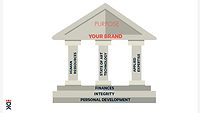Strategies for Survival
Remaining relevant in today’s property restoration and insurance landscape.

The property restoration industry is dynamic and ever-changing. It is exciting, rewarding, and for a savvy business person, can be incredibly lucrative. Many believe it is recession and even pandemic-proof. For those of you who have been around long enough to remember, many service providers actually thrived during our last two major recessions. Many general contractors and carpet cleaners discovered that property restoration could be very profitable when other non-essential industries shrank.
This industry absolutely provides the opportunity for individuals to make a successful living, assuming you are willing to navigate the treacherous seas that property restoration can sometimes present.
I’ve been fortunate to have held executive leadership positions as a contractor, at a restoration software company, and at both the franchisor and managed repair levels of the restoration ecosystem. It is this 20+ years of experience that gives me a unique perspective and understanding of just how much this space has changed. New players, consolidation, and in some cases, fly-by-night operators affect the market every month. The techniques used to restore, the implementation of new technologies, and the sources by which contractors receive work continually evolve.
It goes without saying, that service providers have my utmost respect for the demands that come with restoring lives and property. Today, contractors may feel compelled to sign up for multiple TPA programs and adopt new software tools & systems, all while dealing with ever-increasing competition, unruly demands, wars for talent, and decreased profitability.
When asked fairly regularly what contractors can do to increase revenue and sustain growth, one question always comes to mind: “What are you doing to remain relevant?” This is one of the greatest challenges all businesses face.
Author and executive coach Marshall Goldsmith’s best-selling book, What Got You Here, Won’t Get You There, is a perfect example of how organizations rely on past success to plan the future and often fail to realize that the tools and skills used to get them there will not serve their future successes.
While I and many consultants in our industry could list various strategies for making incremental improvements in your operations, very few of them teach you how to remain relevant. To achieve this, you must truly remain open-minded to new advancements, not only within our industry but also in adjacent industries. To that end, it only makes sense to think that any business is at risk of falling behind the times, if it isn’t actively thinking ahead of the curve.
While that may sound cliché, here are a few easy ways to stay relevant to ensure the next 15-20+ years offer you much more success than you have today.

Be Part of Something Bigger Than You
My number one suggestion is that you cannot continue to sail the vast ocean alone, and must become part of something bigger than yourself. For those who are new to this industry, going the franchise route is a terrific way to be a part of a successful business model that leaves you little room for failure, assuming you operate it properly with the tools you’ve been given.
For independent restorers, joining a larger banner group has proven to be an exceptional opportunity. A banner group often refers to an industry membership group designed for the sole purpose of allowing independent restorers to grow and thrive via direct connection to other restorers, best practices, and more. By learning from fellow entrepreneurs who have been through some of the same challenges, these groups can help your organization see past major roadblocks you are likely facing. Each banner group has a unique value proposition. Find one that promotes and fosters a culture of excellence, integrity, growth, and success, and you are sure not to go wrong. It is my strong belief that all independent restorers must be a part of something larger if they plan to remain relevant and successful for years to come.
I have witnessed this firsthand in having assisted contractors grow their companies by over 10X, simply by accessing the power of a larger peer group, and embracing ongoing educational efforts. This is an area of the industry I happen to be incredibly intimate with as I have helped hundreds of others achieve success through these systems. In business, you cannot be perfect at everything, and these groups give you the ability to lean on them when you need them most.
Lose the Ego
As someone who has operated national organizations filled with hundreds of restorers, I can tell you I have seen my share of egos. It has been my distinct observation that restorers who are humble, actively learning from others, and placing their egos aside prosper tremendously. So many case studies, I could write a book on this alone. Fact of the matter is that even restorers whose companies are earning over $100 million a year have admitted to me that they continue to learn from their mistakes and have made it their mission to learn each and every day.
Writer Thomas Merton once said, “Pride makes us artificial and humility makes us real.” I can speak quite confidently when I say that some of my greatest successes in this industry came when I chose to stop pretending I knew it all, and took the time to learn from another person.
Foster a Culture of Innovation at All Times
This may appear to be obvious, but for many it is not. Contractors tend to simply be a key piece of the puzzle or tool that other companies use to create innovative products and services.
While you may feel as though you don’t have the time to do so when you’re just trying to keep the lights on, it is critical that you foster a culture of innovation and keep your employees engaged. This requires commitment from all levels of your company, and you must schedule time every week to motivate them to share their thoughts. Encourage your team to get creative and bring ideas forward at leadership and other staff meetings. Embrace failure and challenge your employees to think critically. Not only will your company benefit, but your morale and culture will improve as a byproduct.

Track Competition Closely
Closely tracking your competition can be a huge time and money saver. Noting their failures and successes allows you to see which kind of marketing initiatives or products will resonate with your customers, and which ones will fail. I have heard many entrepreneurs say, “We don’t really care about what the competition is doing.” However, there are real advantages in keeping an eye on what they are doing. Are they investing in new services? Are they going after a unique clientele base? Is there a place for your company to fill a void or do something better? Try tracking your competitors regularly for ideas on which new products or services to test, or to see if they are missing something that you can ultimately offer.
2020 has put some of the most impenetrable companies to the test, and remember that what has gotten you to this point, may not be what keeps you in business. The aforementioned strategies are just a few if many, but if implemented properly, could mean the difference between unnecessary struggle and dominating your local markets.
Looking for a reprint of this article?
From high-res PDFs to custom plaques, order your copy today!







